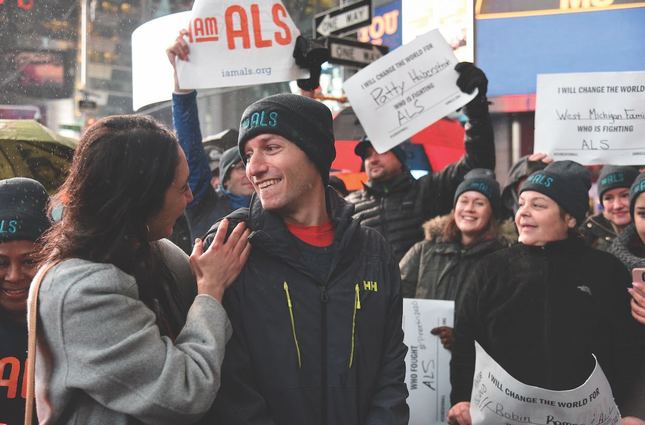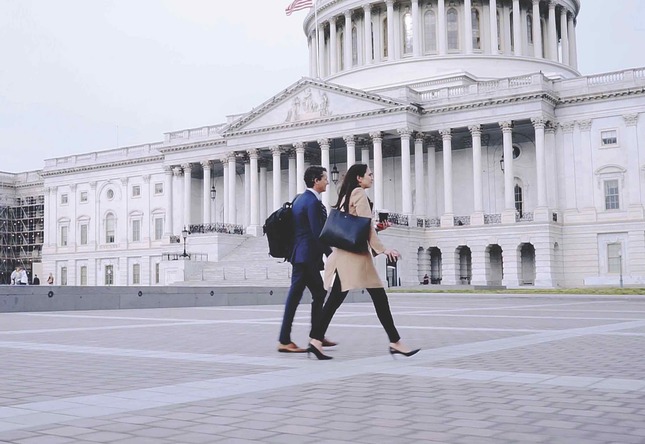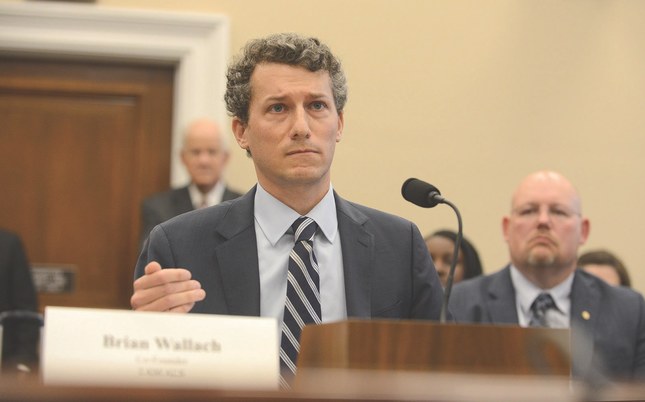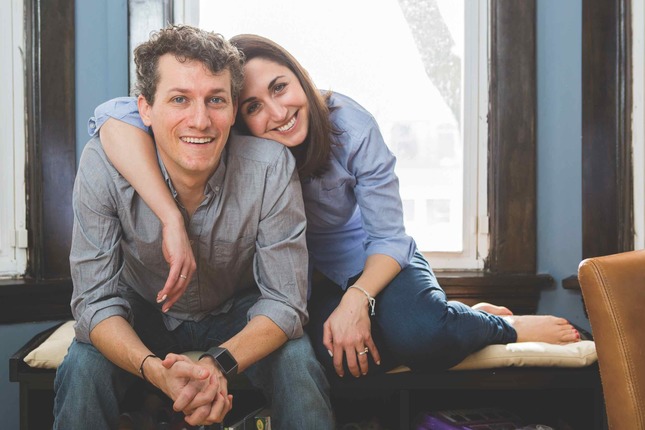
Bob Riha
Diagnosed with ALS in July 2017, Brian Wallach ’03 launched I AM ALS to push for support and a cure. In December 2019, the group took to the streets and the billboards in New York City’s Times Square to call for funding and raise awareness.
View full image

Bob Riha
Diagnosed with ALS in July 2017, Brian Wallach ’03 launched I AM ALS to push for support and a cure. In December 2019, the group took to the streets and the billboards in New York City’s Times Square to call for funding and raise awareness.
View full image

I AM ALS
Wallach met his wife, Sandra Abrevaya, when they worked together on the 2008 Obama campaign. Last August the couple went to Capitol Hill to press their call for greater funding for ALS research.
View full image

I AM ALS
Wallach met his wife, Sandra Abrevaya, when they worked together on the 2008 Obama campaign. Last August the couple went to Capitol Hill to press their call for greater funding for ALS research.
View full image

I AM ALS
Wallach, a lawyer with the US Attorney’s office at the time of his diagnosis, testified before Congress in August 2019 on behalf of those suffering from ALS.
View full image

I AM ALS
Wallach, a lawyer with the US Attorney’s office at the time of his diagnosis, testified before Congress in August 2019 on behalf of those suffering from ALS.
View full image

I AM ALS
Wallach and Abrevaya drew on their experience on political campaigns to build I AM ALS. “We have an urgency that few people ever have in life,” says Wallach.
View full image

I AM ALS
Wallach and Abrevaya drew on their experience on political campaigns to build I AM ALS. “We have an urgency that few people ever have in life,” says Wallach.
View full image
Brian Wallach ’03 was in the maternity ward after the delivery of his second daughter and he could not stop coughing. It was not a deep or phlegmy cough, but so persistent that he often struggled to get out a sentence. It was 2017, in late July. His wife suggested he see a doctor.
Wallach’s primary care physician looked him over two days later and expressed little concern about the cough. He focused instead on the other ongoing symptoms that Wallach described, the hand cramps that sometimes afflicted him when he wrote and the muscle twitches in his shoulders. On the doctor’s recommendation, Wallach visited a neurologist. The next day in the exam room, the neurologist fixed a headlamp to his head, asked Wallach to say “Aah,” then placed a tongue depressor on his tongue and looked down his throat. Several minutes later the doctor explained that Wallach likely had ALS and could have as little as six months to live.
Wallach left the office floating outside of himself. He knew that shattering news comes unannounced: his father had died suddenly of a heart attack during Wallach’s junior year in college. But Wallach was now just 37 years old and in good health. Wasn’t this too soon? He sought the temporary but pure catharsis of expletives, then called Nick Morris ’03, one of his best friends from undergrad days and a critical care neurologist at the University of Maryland. Wallach had a lot of questions. Central among them was how to discuss this with his wife, who had returned home that day from the hospital. New parents embody life. How do they talk about death?
ALS, or amyotrophic lateral sclerosis, is a group of diseases in which the neurons that control voluntary muscle movement waste away. As it progresses, people lose the ability to walk, to talk, eventually to breathe, all while cognition remains unaffected. Lou Gehrig is its most famous patient. Stephen Hawking is another famous patient, though he was atypical given how long he lived. Most people with ALS die of respiratory failure three to five years after their first symptoms appear. The Centers for Disease Control and Prevention estimates that roughly 16,000 Americans have ALS at any given time, with around 5,000 new patients every year. Ninety percent of cases, Wallach’s included, are classified as sporadic, meaning they arise absent risk factors or family history—a stroke of lightning.
Coping with the disease presents an arduous series of challenges, the first being confirmation of the diagnosis itself. This entails a battery of tests by which doctors rule out the many other diseases that sometimes mimic ALS. After Wallach’s first visit to the neurologist, he and his wife, Sandra Abrevaya, saw other specialists, collecting second, third, and fourth opinions until, finally, after several months, they rested with the sad certainty that the original diagnostic hunch had been correct.
But something else emerged from this medical tour. During one appointment Wallach asked the doctor: assuming it is ALS, what would you tell us to do? The doctor reminded them that they are young, with a strong professional network. Wallach at that time was a lawyer with the US Attorney’s Office; he was comfortable with public speaking. “Could you use these assets to help in this fight?” the doctor asked. Two friends called shortly afterward, posing the same question to Wallach.
At another appointment, a doctor in Chicago walked into the exam room with “a sort of faraway look on her face.” He asked why she had this look. She said: hopefully this doesn’t strike you the wrong way, but I come into this room and I see you. You’re educated, your family is behind you, you’ve read every clinical trial and you’re bringing research reports to my attention. The patient I saw before you is not nearly as well off, either in terms of her education or financial resources. She is more or less alone. And yet she is fighting the same fight.
Wallach and Abrevaya had met while working on the 2008 Obama campaign, in New Hampshire, their every day defined by ideals of hope and movement-building. They wondered if they could harness those same ideals to create a nationwide ALS community.
Wallach traveled from city to city, interviewing researchers, doctors, patients, and nonprofit leaders and asking how he might best contribute to the cause. He says he “found people doing amazing work—and heard over and over again that despite this, they somehow weren’t breaking through” to the public. A poll that he commissioned confirmed this: 95 percent of people can’t name a single group working on ALS; 60 percent of people don’t know that ALS is always fatal. He and Abrevaya shaped what they learned into an organization. They called it I AM ALS and launched it in January of 2019, with the aims of supporting the search for a cure and restoring a sense of normalcy to patients’ lives after the bombshell of diagnosis.
I AM ALS set a fundraising goal of $100 million for research over three years. Half of this is expected to come from grassroots contributions and half from increased budget appropriations from the National Institutes of Health. In partnership with other groups, the organization is also creating a pool of funding for early-stage research into ALS, essentially incubating projects until they are mature enough to apply for much larger grants from the NIH. Wallach is justifiably optimistic that more money will unlock a cure; when this cure will be found is the dreadful mystery.
Efforts to reform the patient experience are inspired by Wallach’s own struggles. Receiving the diagnosis folded an uneasy dissonance into his life. How was it that he could die so soon when he felt the same, looked the same, was exercising as he always had? He argued a trial ten days after his initial visit with the neurologist. It was easy to pretend nothing was wrong. “In that first month—even through January, when I had another trial—I was able to keep living life as if nothing had really changed,” he says. “You want that sort of protection as you emotionally try to figure out what’s going on.”
But it proved to be exhausting theater. At parties, people who knew nothing of his illness would ask how he and the family were doing. What was he supposed to say? Such confounding moments were not uncommon. Nor, he realized, were they unique to him. And that made them more troubling. “I was shocked with how little guidance there is for people who find themselves in this situation,” Wallach says.
What guidance might look like, what form it will take, varies from patient to patient and caregiver to caregiver. Some people want to talk through the details of tracheostomy on day one; others don’t. But in response to this need, I AM ALS has built an extensive online community and plans to launch a “patient navigation program” staffed by nurses and social workers. Anybody newly diagnosed can simply call in and say, Okay, talk to me: What do I have? What do I need to think about? What should I do? These conversations will respond not only to looming questions about health, but to financial and emotional concerns as well.
“We want to build a support structure that allows us to be the best dad, the best mom, the best sister or brother without having to focus on what we’ve lost, but instead on who we are and what we have around us,” Wallach says. “That is often hard when you know the end is not just an ephemeral concept, but a real thing.”
Wallach’s diagnosis and subsequent work on health-care policy have brought him into fellowship with Ady Barkan ’10JD, who had embarked on a career as a community organizer after graduating from the Law School and in 2016, at the age of 32, with a four-month-old son, was diagnosed with ALS. Their stories are alike both in the tragedy of recent plot points and the way in which this tragedy has been converted, through unflagging force of will, into raw and restless advocacy. Barkan has set out on a campaign to unseat Republican politicians, elect progressives in their place, and, as he writes it, “save our democracy.” His commitment is fiercest in defense of Medicare for All, about which he testified before the House Committee on Rules in April of 2019. On that day he spoke through a computer using a synthetic voice. A better political system is a legacy he wants to leave for his children. But he may never see the fruits of his labor.
Today, Wallach is an associate attorney in Chicago at Skadden, Arps, the first law firm he worked in after graduating from law school. In 2018, he showed up in court without a tie and received a disapproving look from the bench. Wallach explained to the judge his waning dexterity. He no longer arrives at work in the standard button-down shirt; meeting that dress code would forfeit the 15 minutes he spends each morning with his daughters and wife. (Skadden also lets him work from home three days a week.) He has a hitch in his gait; his speech is quiet, and slightly slurred. He can no longer buckle his daughters into their car seats, and when he joins them in the car he needs to remind himself to duck his head. He is constant witness to the decay of his physical world, its gradual contraction. That, he says, is the hardest thing to grapple with.
Still, Wallach calls himself lucky. His diagnosis came quickly and his symptoms are advancing relatively slowly. A third of patients diagnosed on the same day he was are now dead. He lives with an intensity different from that of recent years, not because his life is richer than it once was, but because he has invested his ambition in the actions of today and next week. His five- and ten-year plans have receded behind his daily commitment to curing ALS and spending time with those he loves. “We,” he says, meaning everyone connected to ALS, “have an urgency that few people ever have in life.” Before his diagnosis, he would tell himself: there will be a time when you can pause and soak this in, when you can enjoy the distance covered and the beauty that fills your life—but for now keep pushing. Today, he embraces the moments he has.
When he pushes now, it’s toward a different set of goals. He is pushing to build and sustain an active ALS community, to mobilize the political and financial resources needed to develop new medicines that will slow and eventually halt the disease’s fatal progression. He is pushing with the hope, however slim, that he might see his daughters grow up and graduate from high school and maybe one day marry and have children of their own. But as backdrop to these efforts there hangs a melancholy pragmatism: the embrace of his ever-growing frailty.
Shortly after the ALS diagnosis, Wallach and Abrevaya renovated their house to accommodate a wheelchair. They widened hallways and doorframes; they constructed a first-floor bedroom and bathroom. They submitted a request to their community’s zoning board of appeals to build a garage that, when the time comes, will fit a minivan with side ramp as well as the medical equipment used to sustain Wallach’s life. “We had the network to be able to help us know what is coming in the next one year, two years, five years,” he says, and they planned accordingly. Wallach insists this is not a minor detail. Awareness allowed him and Abrevaya to respond to the future all at once, and swiftly, rather than as an ongoing series of incremental setbacks. That way they could push aside all those nagging concerns, both grave and quotidian, about what comes next and “simply go back to being in our lives, which is such an amazing gift.”
 loading
loading
6 comments
-

Kristen Eva Shea, 1:55pm August 29 2020 |  Flag as inappropriate
Flag as inappropriate
-

Tammy Bellantoni, 10:27am September 09 2020 |  Flag as inappropriate
Flag as inappropriate
-

Sheryl Vazquez, 10:32am September 09 2020 |  Flag as inappropriate
Flag as inappropriate
-

Rita, 11:17pm September 10 2020 |  Flag as inappropriate
Flag as inappropriate
-

Don Hudson, 11:22am September 16 2020 |  Flag as inappropriate
Flag as inappropriate
-

carol bobley, 10:31am September 27 2020 |  Flag as inappropriate
Flag as inappropriate
The comment period has expired.I have followed Brian on Twitter for a long time. I even have an IAMALS tattoo on my arm. He is constantly an inspiration to others and I am so proud of him for founding IAMALS which is patient focused. His team is always growing in their hard work to help all involved in the ALS community. He is a strong fierce warrior and we are all thankful for his selflessness and his steadfast battle to END ALS. Thank you Brian.
...with faith and hope
Thank you for sharing this story.
This is an incredibly inspiring story. I will donate to IAMALS.
Sheryl
That's light of hope,for the ALS community,ecoureged a lot by reading this essay.With love and peace.
We lost a son to ALS 4 years ago about 2 years after he was diagnosed. Fortunately he was not emotional about it and set to work organizing his estate. He had done well in the private equity field and set up large donations for Massachusetts based Trustees for the Reservations. This nonprofit just purchased Jewel Hill in north central MA with half the money coming from him.
He made another large donation to the Berkeley Divinity School, it is being used to pay travel costs for seniors who make an annual pilgrimage to Canterbury Cathedral.
Thank you for shedding some light on ALS
My husband died from it 10 years ago at age 68 and we as a family are still traumatized by the sudden onset and horrible suffering he had to endure.
There's not enough awareness of this disease to the public.
Quite a few times when I mention ALS to someone they stare blankly at me...and then I have to explain what it is.
I hope that soon there will be something to stop this terrible condition.